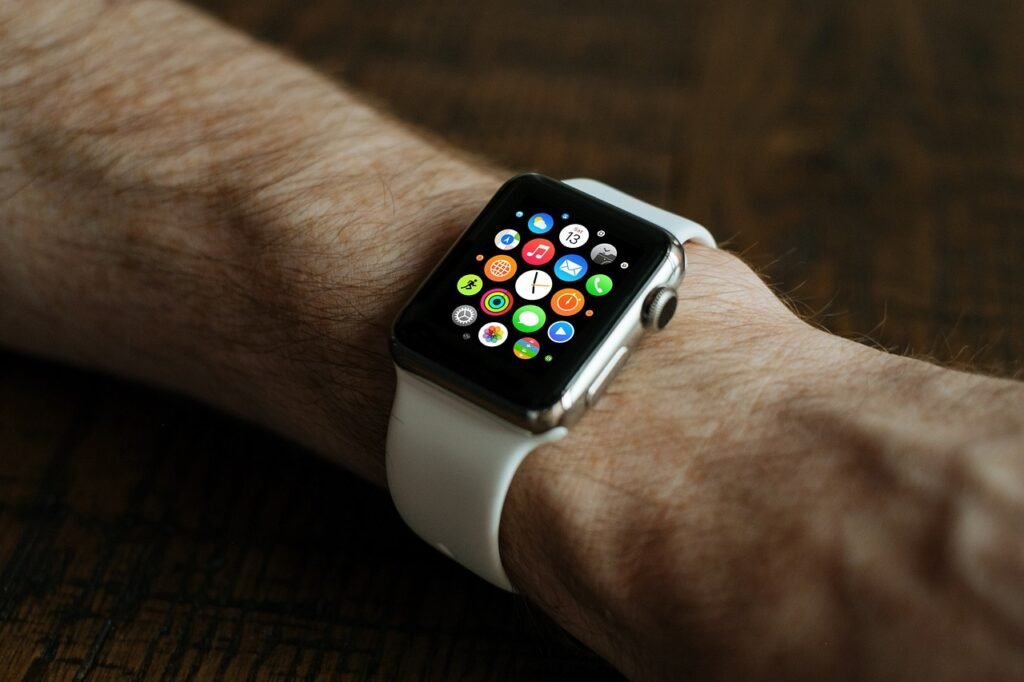Hey there! I’m Ola, and I’ve got a little story to tell about how health technology has completely transformed the wayI look after myself. Honestly, it’s wild how things have changed in just a few years. I remember when “staying healthy” meant the occasional doctor’s visit and reminding myself (mostly unsuccessfully) to take my vitamins. But these days, I’ve got gadgets and apps that keep me on track daily. It’s pretty cool, and I’d love to share my journey with you!
The Day My Watch Gave Me a Wake-Up Call
It all started when my sister gave me an apple smartwatch for my birthday last year. “You’ll love it!” she said. “It’ll count your steps!” I smiled, but in my head, I thought, Great, another thing to forget to charge. I couldn’t have been more wrong.
A month after getting the watch, I was deep into a work project when it started buzzing. I glanced down, and there it was: “Your heart rate is unusually high. Are you okay?” At first, I brushed it off as stress from my deadline, but the buzzing wouldn’t stop. I was feeling a little lightheaded and short of breath, so I finally gave in and checked things out. Long story short, I ended up in the ER where they found a minor heart issue I needed to address.
If it hadn’t been for that watch, I’m not sure how long it would’ve taken for me to notice something was off. That’s when I realized, maybe all this health tech isn’t just about tracking steps—it could actually save lives.
The Apple Watch’s high heart rate alert feature is more than just a cool tech trick—it can be a real lifesaver.
So, how does this life-saving feature actually work?
- Setting up: When you first set up your Apple Watch, it asks you to set a high heart rate threshold. If you don’t choose one, it defaults to 120 beats per minute (BPM).
- Constant vigilance: Your watch is always on the job, regularly checking your heart rate throughout the day using its built-in sensor.
- Smart detection: The watch doesn’t just look at your heart rate—it considers your activity level too. If your heart is racing while you’re running, that’s expected. But if it’s high when you’re sitting still (like I was during my work project), that’s when it gets concerned.
- The alert: If your heart rate goes above your set threshold while you’re inactive for about 10 minutes, your watch springs into action. It buzzes on your wrist and displays a message asking if you’re okay.
- Follow-up: The alert gets logged in the Health app on your iPhone. This way, even if you dismiss it in the moment (like I almost did), you can show it to your doctor later.
Remember, while this feature can be incredibly helpful, it’s not a substitute for regular check-ups or medical advice. If you receive an alert, it’s always best to err on the side of caution and consult with a healthcare professional.
My experience taught me that sometimes, our bodies whisper before they scream. Thanks to my Apple Watch, I was able to hear that whisper and take action. It’s a powerful reminder that technology, when designed thoughtfully, can play a crucial role in maintaining our health and potentially saving lives.
Health Coaching from My Pocket
After that scare, I knew it was time to take my health seriously. I started downloading a few health apps, and let me tell you, it’s like having a health coach in your pocket.
There’s this one app, MyFitnessPal, I love that helps me track what I eat. All I have to do is snap a picture of my meal, and bam—it gives me all the details, from calories to nutrients. It was a little shocking at first. I mean, I didn’t realize just how many snacks I was mindlessly munching on! But the app didn’t just point out my mistakes—it also gave me healthier alternatives. Every once in a while, I’d get notifications like, “Hey Ola, how about a piece of fruit instead of those chips?” (It’s like it knew me too well.)
But MyFitnessPal isn’t the only player in the game. I’ve got friends who swear by other apps:
- Lose It!: My buddy Jake loves this one. He says its user-friendly interface makes logging meals a breeze, and the “Snap It” feature for photo-based food logging is a game-changer. Plus, it lets him set custom goals, which keeps him motivated.
- Noom: My cousin Sarah is all about the psychology of eating. She uses Noom, which focuses on behavioral change and education. It’s like having a personal coach and nutritionist rolled into one app. The color-coded food system helps her make better choices without feeling restricted.
- Cronometer: My health-nut friend Alex is obsessed with this one. It goes deep into nutritional data, tracking not just calories but also vitamins and minerals. Perfect for his super-detailed approach to nutrition.
- FatSecret: My budget-conscious roommate recommends this completely free app. It has a massive food database and even offers meal planning features. She loves the community support—apparently, sharing recipes and tips with other users keeps her accountable.
- Lifesum: My style-savvy sister adores Lifesum’s sleek interface. She says it makes tracking feel less like a chore and more like a fun game. It also syncs with her fitness watch, giving her a complete picture of her health.

The best part? Most of these apps offer free versions, so you can try them out and see which one clicks with you. It’s like dating, but for health apps!
A few weeks in, I started noticing changes. More energy, less afternoon slumps, and hey, my jeans were feeling a bit looser too. Nice little bonus, right?
But it’s not just about the physical changes. These apps have taught me so much about nutrition and portion sizes. Who knew a serving of pasta was so… small? (Okay, maybe nutritionists knew, but it was news to me!)
The key, I’ve found, is consistency. It doesn’t matter which app you choose—what matters is finding one that you’ll actually use day in and day out. For me, that’s MyFitnessPal, but for you, it might be Lose It! or Noom or any of the others.
Remember, these apps are tools, not magic wands. They can guide you, educate you, and keep you accountable, but at the end of the day, you’re the one making the choices. But let me tell you, having all that information at your fingertips? It makes those choices a whole lot easier.
So, if you’re thinking about getting serious about your health, why not give one of these apps a try? Who knows, you might just find your new pocket-sized health coach. And trust me, your future self will thank you!
Virtual Doctor Visits: Surprisingly Not Weird

When the pandemic hit, I wasn’t too keen on heading to the doctor’s office. That’s when I gave telemedicine a shot. I was skeptical—how can a doctor really check you out through a screen? But then I got this annoying rash on my arm. It wasn’t serious enough for the ER, but I wanted some answers. So, I booked a virtual appointment.
Fifteen minutes later, after showing the doctor my rash through the camera and answering a few questions, she diagnosed it as an allergic reaction and sent a prescription straight to my pharmacy. No waiting rooms, no exposure to germs—it was a breeze!
Now, I use telemedicine for minor stuff like prescription refills or little health questions. It’s been a game-changer.
Anxiety Relief at My Fingertips
I’ve always been a bit of an overthinker, and anxiety tends to creep up on me. A friend suggested I try a meditation app, and I figured, why not? I downloaded it, and at first, I felt kind of silly sitting there, listening to the app tell me to “breathe in… breathe out…” But after a while, I realized it was actually helping.
When work stress kicks in, I’ll pop in my headphones, do a quick five-minute session, and suddenly feel like I’ve hit the reset button. They’ve even got sleep meditations that help me doze off when my brain’s doing its late-night worry thing.
The app also tracks my moods, which is pretty interesting. After a few months, I started noticing patterns and figured out some of the triggers behind my anxiety. It’s helped me manage stress in ways I hadn’t even considered.

Here are some of the top meditation apps I’ve tried or heard great things about:
- Headspace: This was my gateway into meditation. It’s like the friendly neighbor of meditation apps – approachable and easy to use. They offer guided meditations for everything from stress to sleep. What I love most is their animated videos that explain meditation concepts. It’s like watching a chill cartoon that teaches you how to relax!
- Calm: A friend recommended this one, and I can see why it’s so popular. Their “Sleep Stories” feature is a game-changer. Imagine being lulled to sleep by the soothing voice of Matthew McConaughey. Alright, alright, alright indeed! They also have a great variety of meditation techniques and breathing exercises.
- Insight Timer: This is the Swiss Army knife of meditation apps. It’s got a massive library of guided meditations from different teachers. The best part? A lot of content is free. It’s perfect for when you want to explore different styles without breaking the bank.
- Ten Percent Happier: This one’s for the skeptics (like I was at first). It was created by a news anchor who was initially cynical about meditation. The app has a no-nonsense approach that I find refreshing. Plus, they have some great courses if you want to dive deeper.
- Waking Up: My tech-savvy friend swears by this one. It’s created by neuroscientist Sam Harris and takes a more scientific approach to meditation. If you’re the type who wants to understand the ‘why’ behind meditation, this might be your jam.
- Buddhify: This one’s unique because it offers meditations for specific situations – like being on a lunch break or waiting in line. Perfect for squeezing mindfulness into a busy day!
Just like with the food tracking apps, the key is to find one that resonates with you. I started with Headspace, but now I’m a mix-and-match meditator, using different apps depending on my mood and needs.
The change in my stress levels has been noticeable. Remember those high heart rate alerts from my watch? They’ve become much less frequent. Plus, I’m sleeping better, and my coworkers have commented that I seem more centered during those high-pressure meetings.
So, if you’re feeling frazzled (and let’s face it, who isn’t these days?), why not give one of these apps a try? You might just find your ticket to a calmer, more focused you. And hey, if Matthew McConaughey’s voice doesn’t relax you, I don’t know what will!
The “Robot” That Watches Over Dad
Okay, it’s not a real robot, but that’s what we like to call it. My dad has diabetes and used to struggle with remembering to check his blood sugar or take his meds on time. For his birthday, we got him this smart pillbox that lights up and makes a sound when it’s time for his meds. If he forgets, it sends a notification to both him and me.
The best part? It connects to his glucose monitor and automatically updates his doctor with his readings. Dad wasn’t toothrilled at first—he didn’t think he needed a “machine” telling him what to do—but now he admits it makes things so much easier. His blood sugar levels are more stable, and it gives all of us peace of mind.
This experience opened my eyes to the world of smart health devices for managing chronic conditions. Here are some other amazing gadgets that are changing lives:
- Continuous Glucose Monitors (CGMs): These devices, like the Dexcom G6 or FreeStyle Libre, continuously track blood sugar levels without the need for constant finger pricks. They can send real-time alerts to your smartphone if levels get too high or low. Some even integrate with insulin pumps to automatically adjust insulin delivery.
- Smart Insulin Pens Devices like InPen or Novo Nordisk’s NovoPen 6 track insulin doses and timing, and can even suggest dosages based on blood glucose levels and carb intake. They sync with smartphone apps to help patients and doctors make more informed decisions.
- Apple Watch with ECG and Fall Detection For those with heart conditions or at risk of falls, the Apple Watch can perform on-the-spot ECGs and detect falls, automatically calling for help if needed. It’s like having a mini health guardian on your wrist!
- Smart Blood Pressure Monitors Devices like Withings BPM Connect or Omron Evolv can track blood pressure over time, sync data to your phone, and even share reports directly with your doctor.
- Breathe Easy with Smart Inhalers For asthma patients, smart inhalers like Propeller or Digihaler can track usage, remind you when it’s time for a dose, and even provide insights into what might be triggering your symptoms.
- Sleep Apnea Helpers Devices like ResMed’s myAir work with CPAP machines to track sleep patterns and machine usage, helping patients get the most out of their therapy.
What amazes me is how these devices are not just about tracking health metrics—they’re about giving people more control over their conditions and more freedom in their daily lives. Dad’s “robot” has made him feel more confident about managing his diabetes, and I’ve seen similar transformations in friends who use other smart health devices.
Of course, it’s important to remember that these gadgets don’t replace medical professionals. Instead, they provide valuable data that can help doctors make better-informed decisions and catch potential issues early.
The best part? Many of these devices integrate with smartphones, creating a comprehensive health dashboard. It’s like having a personal health assistant that never sleeps!
If you or a loved one is managing a chronic condition, it might be worth exploring what smart health devices are available. Who knows? You might just find your own little “robot” to help watch over you or your loved ones. And trust me, the peace of mind is priceless!
Family Step Challenge: The Competitive Side of Fitness
Remember that smartwatch my sister gave me? Well, it turned into a whole family thing. My sister suggested we all get fitness trackers and have a friendly competition. Now, my parents, my sister, and I are all connected on this fitness app, and it gets competitive!
We’ve set a family goal of 10,000 steps a day each, and whoever hits it first gets to choose the movie for our next family night. You should see us all pacing around the house at the end of the day, trying to hit those final steps!
It’s been fun, but more importantly, we’re all moving more, and it’s sparked new conversations. Mom brags about her neighborhood power walks, and Dad’s always discovering new routes for his evening strolls. Plus, we’ve turned post-dinner walks into a family tradition whenever we get together.

This experience has shown me the power of social motivation in fitness. Here are some popular apps and features that can help turn fitness into a family (or friends) affair:
- Fitbit Challenges: Fitbit offers various challenges like “Workweek Hustle” or “Weekend Warrior” where you can compete with friends and family. They even have “Adventures” where you can virtually hike famous trails together.
- Strava: This app is great for runners and cyclists. You can create clubs for your family or friend group, share routes, and cheer each other on with kudos.
- Nike Run Club: Their guided runs are fantastic, but what’s really cool is the ability to send audio cheers to your friends mid-run. Nothing like hearing your mom’s voice telling you to “Pick up the pace!” halfway through a 5K!
- Pokemon Go: Yes, it’s still a thing! This game gets the whole family out walking while catching virtual creatures. It’s especially great for getting kids excited about being active.
- Charity Miles: This app lets you earn money for charity while you exercise. You could set a family goal to raise a certain amount for a cause you all care about.
- Zwift: If your family is into cycling, Zwift lets you ride together in a virtual world, even if you’re miles apart. It’s great for those rainy days or when you can’t all be in the same place.
- Apple Fitness+ :For Apple users, this service offers group workouts where you can see each other’s progress rings filling up in real-time. It’s like having a family gym session right in your living room!
The key to making these challenges work is to keep them fun and inclusive. We made sure to choose activities that everyone could participate in, regardless of fitness level. And we’re always adjusting our goals to keep things challenging but achievable.
One unexpected benefit? It’s opened up conversations about health that we might not have had otherwise. We’re sharing healthy recipes, swapping workout tips, and supporting each other’s wellness goals beyond just step counts.
And it’s not just about competition. We celebrate each other’s achievements, big and small. When Mom hit her first 15,000-step day, we all cheered her on in the app’s chat and treated her to a healthy brunch the next weekend.
If you’re looking to get your family or friends more active, why not start a challenge of your own? It doesn’t have to be steps – you could track active minutes, workouts completed, or even water intake. The important thing is finding something that gets everyone excited and moving.
Remember, the goal isn’t to create pressure, but to build healthy habits together. And who knows? You might just discover a new family tradition in the process. After all, there’s nothing quite like the combination of fresh air, endorphins, and family banter to bring everyone closer together!




